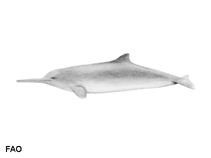Pontoporia blainvillei (Gervais & d'Orbigny, 1844)
Franciscana| Native range | All suitable habitat | Point map | Year 2050 |

|
| This map was computer-generated and has not yet been reviewed. |
| Pontoporia blainvillei AquaMaps Data sources: GBIF OBIS |
Classification / Names Common names | Synonyms | CoL | ITIS | WoRMS
Mammalia | Cetartiodactyla | Iniidae
Environment: milieu / climate zone / depth range / distribution range Ecology
Pelagic; brackish. Temperate; 0°N - 90°S, 180°W - 180°E
Distribution Countries | FAO areas | Ecosystems | Occurrences | Introductions
Southwest Atlantic: Argentina and Brazil. [Rio Grande do Sul/Uruguay population: IUCN 2010 (Ref. 84930): VU, A2d.]
Length at first maturity / Size / Weight / Age
Maturity: Lm ? range ? - ? cm Max length : 163 cm TL male/unsexed; (Ref. 1394); 177 cm TL (female); max. published weight: 34.0 kg (Ref. 1394)
Found in coastal areas, but may be found in some estuaries and sporadically enter the la Plata river. Feeds mostly near the bottom on several species of fish, cephalopods, and crustaceans (Ref. 1394).
Life cycle and mating behavior Maturity | Reproduction | Spawning | Eggs | Fecundity | Larvae
Main reference
References | Coordinator | Collaborators
Jefferson, T.A., S. Leatherwood and M.A. Webber. 1993. (Ref. 1394)
IUCN Red List Status (Ref. 130435: Version 2024-1)
Vulnerable (VU) (A3d); Date assessed: 14 August 2017
CITES status (Ref. 108899)
Appendix II: International trade monitored
CMS (Ref. 116361)
Appendix I & II: Endangered migratory species conserved through agreements
Threat to humans
Human uses
Fisheries: commercial
FAO - Fisheries: landings, species profile | FishSource | Sea Around Us
Tools
More information
Trophic Ecology
Ecology
Population dynamics
Life cycle
Reproduction
Maturity
Fecundity
Spawning
Eggs
Egg development
Larvae
Larval dynamics
Maturity
Fecundity
Spawning
Eggs
Egg development
Larvae
Larval dynamics
Distribution
Human Related
Aquaculture profile
Stamps, Coins Misc.
Stamps, Coins Misc.
Outreach
Taxonomy
References
Internet sources
BHL | BOLD Systems | CISTI | DiscoverLife | FAO(Fisheries: species profile; publication : search) | Fishipedia | GenBank (genome, nucleotide) | GloBI | Gomexsi | Google Books | Google Scholar | Google | PubMed | Tree of Life | Wikipedia (Go, Search) | Zoological Record
Estimates based on models
Preferred temperature
(Ref. 115969): 12 - 24.7, mean 16.1 (based on 318 cells).
Resilience
(Ref. 69278):
High, minimum population doubling time less than 15 months (K=0.33-1.14).
Price category
(Ref. 80766):
Unknown.



